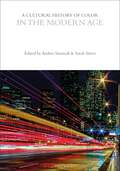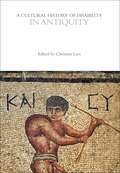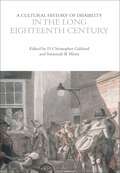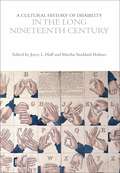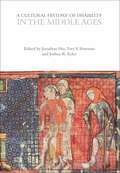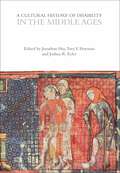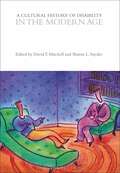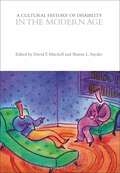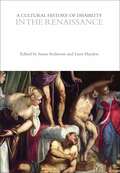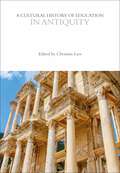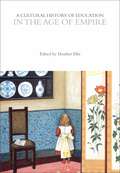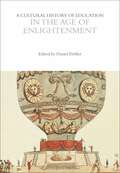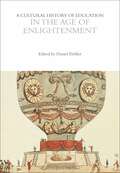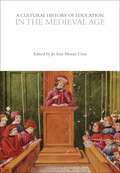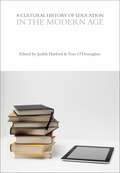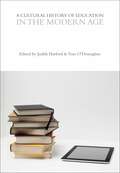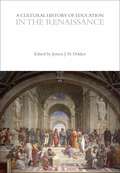- Table View
- List View
A Cultural History of Color in the Modern Age (The Cultural Histories Series)
by Anders Steinvall and Sarah StreetA Cultural History of Color in the Modern Age covers the period 1920 to the present, a time of extraordinary developments in colour science, philosophy, art, design and technologies. The expansion of products produced with synthetic dyes was accelerated by mass consumerism as artists, designers, architects, writers, theater and filmmakers made us a 'color conscious' society. This influenced what we wore, how we chose to furnish and decorate our homes, and how we responded to the vibrancy and chromatic eclecticism of contemporary visual cultures.The volume brings together research on how philosophers, scientists, linguists and artists debated color's polyvalence, its meaning to different cultures, and how it could be measured, manufactured, manipulated and enjoyed. Color shapes an individual's experience of the world and also how society gives particular spaces, objects, and moments meaning. The 6 volume set of the Cultural History of Color examines how color has been created, traded, used, and interpreted over the last 5000 years. The themes covered in each volume are color philosophy and science; color technology and trade; power and identity; religion and ritual; body and clothing; language and psychology; literature and the performing arts; art; architecture and interiors; and artefacts. Anders Steinvall is Senior Lecturer in English Linguistics at Umeå University, Sweden. Sarah Street is Professor of Film at the University of Bristol, UK. Volume 6 in the Cultural History of Color set. General Editors: Carole P. Biggam and Kirsten Wolf
A Cultural History of Color in the Modern Age (The Cultural Histories Series)
A Cultural History of Color in the Modern Age covers the period 1920 to the present, a time of extraordinary developments in colour science, philosophy, art, design and technologies. The expansion of products produced with synthetic dyes was accelerated by mass consumerism as artists, designers, architects, writers, theater and filmmakers made us a 'color conscious' society. This influenced what we wore, how we chose to furnish and decorate our homes, and how we responded to the vibrancy and chromatic eclecticism of contemporary visual cultures.The volume brings together research on how philosophers, scientists, linguists and artists debated color's polyvalence, its meaning to different cultures, and how it could be measured, manufactured, manipulated and enjoyed. Color shapes an individual's experience of the world and also how society gives particular spaces, objects, and moments meaning. The 6 volume set of the Cultural History of Color examines how color has been created, traded, used, and interpreted over the last 5000 years. The themes covered in each volume are color philosophy and science; color technology and trade; power and identity; religion and ritual; body and clothing; language and psychology; literature and the performing arts; art; architecture and interiors; and artefacts. Anders Steinvall is Senior Lecturer in English Linguistics at Umeå University, Sweden. Sarah Street is Professor of Film at the University of Bristol, UK. Volume 6 in the Cultural History of Color set. General Editors: Carole P. Biggam and Kirsten Wolf
A Cultural History of Disability in Antiquity (The Cultural Histories Series)
by Christian LaesThough there was not even a word for, or a concept of, disability in Antiquity, a considerable part of the population experienced physical or mental conditions that put them at a disadvantage. Drawing on a wide variety of sources, from literary texts and legal sources to archaeological and iconographical evidence as well as comparative anthropology, this volume uniquely examines contexts and conditions of disability in the ancient world. An essential resource for researchers, scholars and students of history, literature, culture and education, A Cultural History of Disability in Antiquity explores such themes and topics as: atypical bodies; mobility impairment; chronic pain and illness; blindness; deafness; speech; learning difficulties; and mental health.
A Cultural History of Disability in Antiquity (The Cultural Histories Series)
by Christian LaesThough there was not even a word for, or a concept of, disability in Antiquity, a considerable part of the population experienced physical or mental conditions that put them at a disadvantage. Drawing on a wide variety of sources, from literary texts and legal sources to archaeological and iconographical evidence as well as comparative anthropology, this volume uniquely examines contexts and conditions of disability in the ancient world. An essential resource for researchers, scholars and students of history, literature, culture and education, A Cultural History of Disability in Antiquity explores such themes and topics as: atypical bodies; mobility impairment; chronic pain and illness; blindness; deafness; speech; learning difficulties; and mental health.
A Cultural History of Disability in the Long Eighteenth Century (The Cultural Histories Series)
by D. Christopher Gabbard and Susannah B. MintzEighteenth-century philosopher Edmund Burke wrote, 'deformity is opposed, not to beauty, but to the complete, common form. If one of the legs of a man be found shorter than the other, the man is deformed; because there is something wanting to complete the whole idea we form of a man'. During the long eighteenth century, new ideas from aesthetics and the emerging scientific disciplines of physics, biology and zoology contributed to changing fundamental notions about human form, function and ability. The interrelated concepts of the natural and the beautiful coalesced into a hegemonic ideology of form, one which defined communal standards regarding which aspects of human appearance and ability would be considered typical and socially acceptable and which would not.An essential resource for researchers, scholars and students of history, literature, culture and education, A Cultural History of Disability in the Long Eighteenth Century explores such themes and topics as: atypical bodies; mobility impairment; chronic pain and illness; blindness; deafness; speech; learning difficulties; and mental health.
A Cultural History of Disability in the Long Nineteenth Century (The Cultural Histories Series)
by Joyce L. Huff Martha Stoddard HolmesThe long nineteenth century-stretching from the start of the American Revolution in 1776 to the end of World War I in 1918-was a pivotal period in the history of disability for the Western world and the cultures under its imperial sway. Industrialization was a major factor in the changing landscape of disability, providing new adaptive technologies and means of access while simultaneously contributing to the creation of a mass-produced environment hostile to bodies and minds that did not adhere to emerging norms. In defining disability, medical views, which framed disabilities as problems to be solved, competed with discourses from such diverse realms as religion, entertainment, education, and literature. Disabled writers and activists generated important counternarratives, made increasingly available through the spread of print culture.An essential resource for researchers, scholars and students of history, literature, culture and education, A Cultural History of Disability in the Long Nineteenth Century includes chapters on atypical bodies, mobility impairment, chronic pain and illness, blindness, deafness, speech dysfluencies, learning difficulties, and mental health, with 34 illustrations drawn from period sources.
A Cultural History of Disability in the Long Nineteenth Century (The Cultural Histories Series)
by Joyce L. Huff and Martha Stoddard HolmesThe long nineteenth century-stretching from the start of the American Revolution in 1776 to the end of World War I in 1918-was a pivotal period in the history of disability for the Western world and the cultures under its imperial sway. Industrialization was a major factor in the changing landscape of disability, providing new adaptive technologies and means of access while simultaneously contributing to the creation of a mass-produced environment hostile to bodies and minds that did not adhere to emerging norms. In defining disability, medical views, which framed disabilities as problems to be solved, competed with discourses from such diverse realms as religion, entertainment, education, and literature. Disabled writers and activists generated important counternarratives, made increasingly available through the spread of print culture.An essential resource for researchers, scholars and students of history, literature, culture and education, A Cultural History of Disability in the Long Nineteenth Century includes chapters on atypical bodies, mobility impairment, chronic pain and illness, blindness, deafness, speech dysfluencies, learning difficulties, and mental health, with 34 illustrations drawn from period sources.
A Cultural History of Disability in the Middle Ages (The Cultural Histories Series)
by Jonathan Hsy Tory V. Pearman Joshua R. EylerThe Middle Ages was an era of dynamic social transformation, and notions of disability in medieval culture reflected how norms and forms of embodiment interacted with gender, class, and race, among other dimensions of human difference. Ideas of disability in courtly romance, saints' lives, chronicles, sagas, secular lyrics, dramas, and pageants demonstrate the nuanced, and sometimes contradictory, relationship between cultural constructions of disability and the lived experience of impairment.An essential resource for researchers, scholars, and students of history, literature, visual art, cultural studies, and education, A Cultural History of Disability in the Middle Ages explores themes and topics such as atypical bodies; mobility impairment; chronic pain and illness; blindness; deafness; speech; learning difficulties; and mental health.
A Cultural History of Disability in the Middle Ages (The Cultural Histories Series)
by Jonathan Hsy, Tory V. Pearman and Joshua R. EylerThe Middle Ages was an era of dynamic social transformation, and notions of disability in medieval culture reflected how norms and forms of embodiment interacted with gender, class, and race, among other dimensions of human difference. Ideas of disability in courtly romance, saints' lives, chronicles, sagas, secular lyrics, dramas, and pageants demonstrate the nuanced, and sometimes contradictory, relationship between cultural constructions of disability and the lived experience of impairment.An essential resource for researchers, scholars, and students of history, literature, visual art, cultural studies, and education, A Cultural History of Disability in the Middle Ages explores themes and topics such as atypical bodies; mobility impairment; chronic pain and illness; blindness; deafness; speech; learning difficulties; and mental health.
A Cultural History of Disability in the Modern Age (The Cultural Histories Series)
by David T. Mitchell and Sharon L. SnyderIf eugenics -- the science of eliminating kinds of undesirable human beings from the species record -- came to overdetermine the late nineteenth century in relation to disability, the twentieth century may be best characterized as managing the repercussions for variable human populations. A Cultural History of Disability in the Modern Age provides an interdisciplinary overview of disability as an outpouring of professional, political, and representational efforts to fix, correct, eliminate, preserve, and even cultivate the value of crip bodies. This book pursues analyses of disability's deployment as a wellspring for an alternative ethics of living in and alongside the body different while simultaneously considering the varied social and material contexts of devalued human differences from World War I to the present. In short, this volume demonstrates that, in Ozymandias-like ways, the Western Project of the Human with its perpetuation of bodymind hierarchies lies crumbling in the deserts of failed empires, genocidal furies, and the rejuvenating myths of new nation states in the 20th century. An essential resource for researchers, scholars and students of history, literature, culture, philosophy, rehabilitation, technology, and education, A Cultural History of Disability in the Modern Age explores such themes and topics as: atypical bodies; mobility impairment; chronic pain and illness; blindness; deafness; speech; learning difficulties; and mental health while wrestling with their status as unreliable predictors of what constitutes undesirable humanity.
A Cultural History of Disability in the Modern Age (The Cultural Histories Series)
by David T. Mitchell Sharon L. SnyderIf eugenics -- the science of eliminating kinds of undesirable human beings from the species record -- came to overdetermine the late nineteenth century in relation to disability, the twentieth century may be best characterized as managing the repercussions for variable human populations. A Cultural History of Disability in the Modern Age provides an interdisciplinary overview of disability as an outpouring of professional, political, and representational efforts to fix, correct, eliminate, preserve, and even cultivate the value of crip bodies. This book pursues analyses of disability's deployment as a wellspring for an alternative ethics of living in and alongside the body different while simultaneously considering the varied social and material contexts of devalued human differences from World War I to the present. In short, this volume demonstrates that, in Ozymandias-like ways, the Western Project of the Human with its perpetuation of bodymind hierarchies lies crumbling in the deserts of failed empires, genocidal furies, and the rejuvenating myths of new nation states in the 20th century. An essential resource for researchers, scholars and students of history, literature, culture, philosophy, rehabilitation, technology, and education, A Cultural History of Disability in the Modern Age explores such themes and topics as: atypical bodies; mobility impairment; chronic pain and illness; blindness; deafness; speech; learning difficulties; and mental health while wrestling with their status as unreliable predictors of what constitutes undesirable humanity.
A Cultural History of Disability in the Renaissance (The Cultural Histories Series)
by Susan Anderson Liam HaydonIn Renaissance humanism, difference was understood through a variety of paradigms that rendered particular kinds of bodies and minds disabled. A Cultural History of Disability in the Renaissance, covering the period from 1450 to 1650, explores evidence of the possibilities for disability that existed in the European Renaissance, observable in the literary and medicinal texts, and the family, corporate, and legal records discussed in the chapters of this volume. These chapters provide an interdisciplinary overview of the configurations of bodies, minds and collectives that have left evidence of some of the ways that normativity and its challengers interacted in the Renaissance.An essential resource for researchers, scholars and students of history, literature, culture and education, A Cultural History of Disability in the Renaissance explores such themes and topics as: atypical bodies; mobility impairment; chronic pain and illness; blindness; deafness; speech; learning difficulties; and mental health.
A Cultural History of Disability in the Renaissance (The Cultural Histories Series)
by Susan Anderson and Liam HaydonIn Renaissance humanism, difference was understood through a variety of paradigms that rendered particular kinds of bodies and minds disabled. A Cultural History of Disability in the Renaissance, covering the period from 1450 to 1650, explores evidence of the possibilities for disability that existed in the European Renaissance, observable in the literary and medicinal texts, and the family, corporate, and legal records discussed in the chapters of this volume. These chapters provide an interdisciplinary overview of the configurations of bodies, minds and collectives that have left evidence of some of the ways that normativity and its challengers interacted in the Renaissance.An essential resource for researchers, scholars and students of history, literature, culture and education, A Cultural History of Disability in the Renaissance explores such themes and topics as: atypical bodies; mobility impairment; chronic pain and illness; blindness; deafness; speech; learning difficulties; and mental health.
A Cultural History of Education in Antiquity (The Cultural Histories Series)
by Christian LaesA Cultural History of Education in Antiquity presents essays that examine the following key themes of the period: church, religion and morality; knowledge, media and communications; children and childhood; family, community and sociability; learners and learning; teachers and teaching; literacies; and life histories.The book balances traditional approaches towards education with the new history of education that tackles the topic from a much broader scope. The chapters integrate evidence from the Greek and the Roman world, next to Christian evidence from late antiquity.An essential resource for researchers, scholars, and students in history, literature, culture, and education.
A Cultural History of Education in Antiquity (The Cultural Histories Series)
A Cultural History of Education in Antiquity presents essays that examine the following key themes of the period: church, religion and morality; knowledge, media and communications; children and childhood; family, community and sociability; learners and learning; teachers and teaching; literacies; and life histories.The book balances traditional approaches towards education with the new history of education that tackles the topic from a much broader scope. The chapters integrate evidence from the Greek and the Roman world, next to Christian evidence from late antiquity.An essential resource for researchers, scholars, and students in history, literature, culture, and education.
A Cultural History of Education in the Age of Empire (The Cultural Histories Series)
by Heather EllisA Cultural History of Education in the Age of Empire presents essays that examine the following key themes of the period: church, religion and morality; knowledge, media and communications; children and childhood; family, community and sociability; learners and learning; teachers and teaching; literacies; and life histories.The period between 1800 and 1920 was pivotal in the global history of education and witnessed many of the key developments which still shape the aims, context and lived experience of education today. These developments included the spread of state sponsored mass elementary education; the efforts of missionary societies and other voluntary movements; the resistance, agency and counter-initiatives developed by indigenous and other colonized peoples as well as the increasingly complex cross border encounters and movements which characterized much educational activity by the end of this period.An essential resource for researchers, scholars, and students in history, literature, culture, and education.
A Cultural History of Education in the Age of Empire (The Cultural Histories Series)
A Cultural History of Education in the Age of Empire presents essays that examine the following key themes of the period: church, religion and morality; knowledge, media and communications; children and childhood; family, community and sociability; learners and learning; teachers and teaching; literacies; and life histories.The period between 1800 and 1920 was pivotal in the global history of education and witnessed many of the key developments which still shape the aims, context and lived experience of education today. These developments included the spread of state sponsored mass elementary education; the efforts of missionary societies and other voluntary movements; the resistance, agency and counter-initiatives developed by indigenous and other colonized peoples as well as the increasingly complex cross border encounters and movements which characterized much educational activity by the end of this period.An essential resource for researchers, scholars, and students in history, literature, culture, and education.
A Cultural History of Education in the Age of Enlightenment (The Cultural Histories Series)
by Daniel TröhlerA Cultural History of Education in the Age of Enlightenment presents essays that examine the following key themes of the period: church, religion and morality; knowledge, media and communications; children and childhood; family, community and sociability; learners and learning; teachers and teaching; literacies; and life histories.The Age of Enlightenment is characterized by a growing belief in the human capacity to change the world. This volume shows how the educational endeavors of the period contributed in their diversity to a thoroughly educationalized culture around 1800, the very foundation of the modern nation state, which then developed into the long 19th century.An essential resource for researchers, scholars, and students in history, literature, culture, and education.
A Cultural History of Education in the Age of Enlightenment (The Cultural Histories Series)
A Cultural History of Education in the Age of Enlightenment presents essays that examine the following key themes of the period: church, religion and morality; knowledge, media and communications; children and childhood; family, community and sociability; learners and learning; teachers and teaching; literacies; and life histories.The Age of Enlightenment is characterized by a growing belief in the human capacity to change the world. This volume shows how the educational endeavors of the period contributed in their diversity to a thoroughly educationalized culture around 1800, the very foundation of the modern nation state, which then developed into the long 19th century.An essential resource for researchers, scholars, and students in history, literature, culture, and education.
A Cultural History of Education in the Medieval Age (The Cultural Histories Series)
by Jo Ann H. Moran CruzA Cultural History of Education in the Medieval Age presents essays that examine the following key themes of the period: church, religion and morality; knowledge, media and communications; children and childhood; family, community and sociability; learners and learning; teachers and teaching; literacies; and life histories.The medieval world was a rich blend of cultures and religions within which individuals were shaped and schooled. Men and women learned, taught, worked, fought, and prayed in social contexts that witnessed an expansion of literacy and learning. The chapters in this volume illustrate the extent to which medieval education formed the foundation of the modern educational enterprise.An essential resource for researchers, scholars, and students in history, literature, culture, and education.
A Cultural History of Education in the Medieval Age (The Cultural Histories Series)
A Cultural History of Education in the Medieval Age presents essays that examine the following key themes of the period: church, religion and morality; knowledge, media and communications; children and childhood; family, community and sociability; learners and learning; teachers and teaching; literacies; and life histories.The medieval world was a rich blend of cultures and religions within which individuals were shaped and schooled. Men and women learned, taught, worked, fought, and prayed in social contexts that witnessed an expansion of literacy and learning. The chapters in this volume illustrate the extent to which medieval education formed the foundation of the modern educational enterprise.An essential resource for researchers, scholars, and students in history, literature, culture, and education.
A Cultural History of Education in the Modern Age (The Cultural Histories Series)
by Judith Harford and Tom O’DonoghueA Cultural History of Education in the Modern Age presents essays that examine the following key themes of the period: church, religion and morality; knowledge, media and communications; children and childhood; family, community and sociability; learners and learning; teachers and teaching; literacies; and life histories.The twentieth century brought profound and far-reaching changes to education systems globally in response to significant social, economic, and political transformation. This volume draws together work from leading historians of education to present a tapestry of seminal and enduring themes that characterize the many educational developments since 1920.An essential resource for researchers, scholars, and students in history, literature, culture, and education.
A Cultural History of Education in the Modern Age (The Cultural Histories Series)
A Cultural History of Education in the Modern Age presents essays that examine the following key themes of the period: church, religion and morality; knowledge, media and communications; children and childhood; family, community and sociability; learners and learning; teachers and teaching; literacies; and life histories.The twentieth century brought profound and far-reaching changes to education systems globally in response to significant social, economic, and political transformation. This volume draws together work from leading historians of education to present a tapestry of seminal and enduring themes that characterize the many educational developments since 1920.An essential resource for researchers, scholars, and students in history, literature, culture, and education.
A Cultural History of Education in the Renaissance (The Cultural Histories Series)
by Jeroen J.H. DekkerA Cultural History of Education in the Renaissance presents essays that examine the following key themes of the period: church, religion and morality; knowledge, media and communications; children and childhood; family, community and sociability; learners and learning; teachers and teaching; literacies; and life histories.Education was the fuel for the communication and knowledge society of the Renaissance. This period saw increasing investments in educational institutions to meet the growing demand for literacy in the context of a religiously divided Europe with growing cities and emerging central governments.An essential resource for researchers, scholars, and students in history, literature, culture, and education.
A Cultural History of Education in the Renaissance (The Cultural Histories Series)
A Cultural History of Education in the Renaissance presents essays that examine the following key themes of the period: church, religion and morality; knowledge, media and communications; children and childhood; family, community and sociability; learners and learning; teachers and teaching; literacies; and life histories.Education was the fuel for the communication and knowledge society of the Renaissance. This period saw increasing investments in educational institutions to meet the growing demand for literacy in the context of a religiously divided Europe with growing cities and emerging central governments.An essential resource for researchers, scholars, and students in history, literature, culture, and education.
